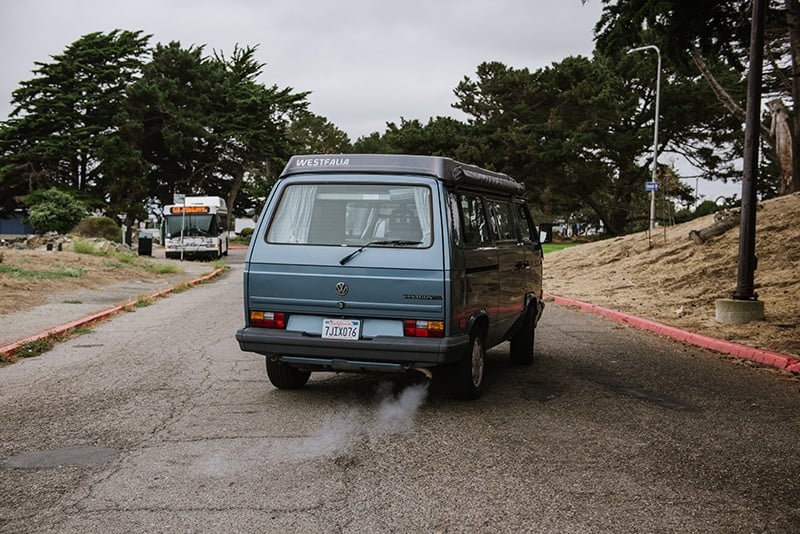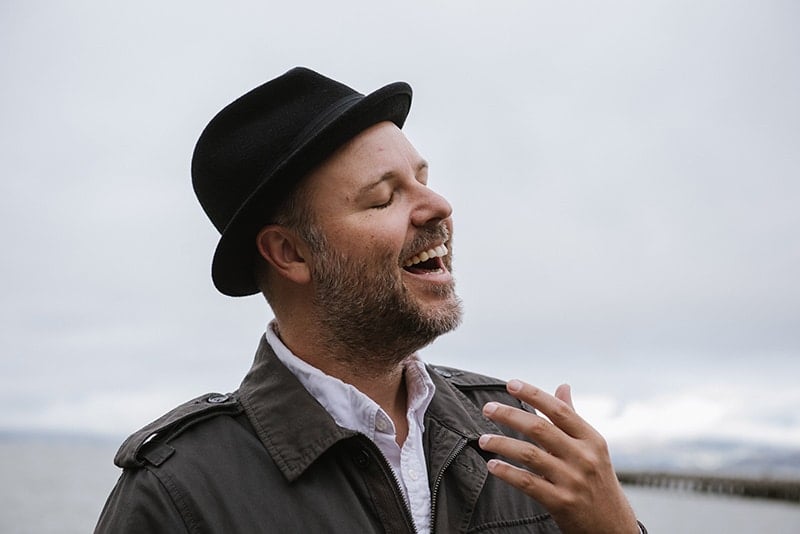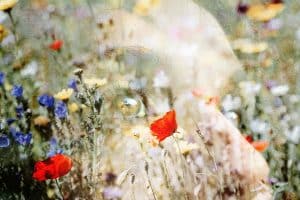“A lightning bolt to the brain” is how Zac Kamenetz describes his first mystical experience. He was only 15, on a youth trip to the Holy Land, looking out over the archeological site of Tel Gezer in the Judean foothills. “In that moment, I felt my brain open up to a new reality: God is real.” The epiphany came in a fleeting instant, he says, “but the integration work has lasted all my life.”
Since that moment, one question has shaped the arch of Kamenetz’ life work: How do “non-ordinary states of consciousness,” as he calls them, inform or enhance our experience of religion?
Hailing from a nominally reform Jewish family, the teenager’s brush with the divine came endogenously. Random, if you will. Unsure what to make of it, he immediately put on a yarmulke (Jewish skullcap). He’s been wearing one ever since.

Waiting in line for coffee at the famed Cheese Board Collective in Berkeley, I initially miss Rabbi Kamenetz when he walks in. I’m expecting the long, greying beard I’d seen on his Facebook page— instead, I’m greeted by a fresh-faced 30-something in sandals, cargo shorts, and a floral baseball cap.
It’s a sunny Friday morning as we carry our scones and coffee back to his big blue van parked around the corner, seeking a quiet place to chat. Kamenetz’ neighbors pass us, he drops a “Shabbat Shalom” to one, and later some cash to a homeless man outside the van.

There’s a car seat in the van for his two-year-old daughter. Some Jewish literature is stacked by a curtained window. He flips the front passenger seat around to face the back row and dishes on what it was like to be a subject in the Johns Hopkins study on religious professionals—a trial giving psilocybin (the psychoactive component of shrooms) to rabbis, priests, and imams who have never tried psychedelics.
How to Grow Shrooms Bundle
Take Both of Our Courses and Save $90!
In part, the study investigates the mystical experience, a hard-to-describe experience some might explain as connecting with God or a sense of divine knowing. These experiences can be caused naturally through meditation or prayer, but also through the use of psychedelics—and they often shape the course of a person’s life.
Scientists measure these experiences according to specific criteria, such as ineffability (an inability to describe the experience with words), transcendence of time and space, feelings of unity, a sense of sacredness, a noetic quality (a sense of ultimate reality), and deeply felt positivity. The idea is that, by virtue of their training, vocabulary, and spiritual orientation, religious professionals are aptly suited to help researchers better understand the nature of mystical experiences, whether they’re occasioned by psychedelics or not.
But there’s another point to the research, adds Kamenetz, and that’s to explore how a profound mystical experience—like the ones often had on psychedelics—can treat what scientists have called “clergy burnout.” In other words, how can reconnecting with the mysticism behind religious practice and leadership renew your commitment to them?
“We have lost touch with the core of what actually started Judaism in the first place, and that’s that mystical fire. I want to help reignite it.”
In Kamenetz’ case that’s a no-brainer: In two psilocybin sessions six months apart, he had a mystical experience the first time, although not the second. Reconciling the meaning of this, and integrating it into his personal and professional outlook, Kamenetz is now channeling his work into what he dubs the Jewish Entheogenic Society. He aims to educate the mainstream Jewish community about psychedelic research, share his story, eventually train to be a psychedelic guide himself, and potentially in the far out future—in the context of decriminalization—open a center where those on the religious path can prepare for and integrate a psychedelic experience in a Jewish setting.
With the prevalence of intergenerational trauma and psychedelic drug use within the Jewish community (many rabbis who applied to the study were disqualified for prior history with psychedelics), lord knows there’s a need for it. But underlying that is another function to Kamenetz’ work: “We have lost touch with the core of what actually started Judaism in the first place, and that’s that mystical fire,” he says. “I want to help reignite it.”

Indeed, Judaism, like many of the world’s oldest religions, developed around the ceremonial use of plant medicines. One might argue that the rituals and ethos of the religion are an expression of altered states.
“From my perspective, if you’re finding certain chemicals in your brain and certain chemicals in the earth, and they’re found in the story of the Torah [Bible], there’s already a crossover between them and a mystery we have to solve,” says Rabbi Harry Rozenberg, co-founder of the Theological Research Institute, and an expert on psychoactive plants in Jewish text. “We shouldn’t have to defend the fact that there are locks in our brain and keys throughout planet earth.”
These “locks and keys” Rozenberg refers to can be interpreted as what’s called, in Jewish theology, nitzotzot—divine sparks of holiness. It’s believed that these sparks are not only scattered throughout the earth, but also exist within us. But to elevate our internal, soulful divinity, we need to redeem the scattered nitzotzot throughout the earth. And that, Rozenberg theorizes, is where plant medicine comes in. The nitzotzot can be extracted from the earth via plants which activate divine, even prophetic, states of consciousness. This has always been a part of Jewish practice.

As it turns out, Egyptian mythology is closely tied to acacia, a native Middle Eastern tree containing DMT, known to occasion prophetic states. (DMT also naturally occurs within the human brain.) When Moses led the ancient Hebrews out of Egypt, they brought with them knowledge of Egyptian methodology around making acacia extract. Then Moses saw the burning bush and spoke to God: You can fill in the blanks.
Other aspects of Judaism are informed by plant medicine, too. Once a year on the day of atonement, the high priest of the ancient temple of Jerusalem was commanded to stand in a room filled with the smoke of incense that some argue was made with kaneh-bosm (cannabis) extract and lit up by coals made from acacia wood, and pray on behalf of the Jewish people. Later in history, European rabbis developed a tradition of smoking from herbal pipes—not altogether different from Native American traditions. “Very mystical things happened when the Hasidic rabbi hit his pipe,” explains Rozenberg. “The reason they do it is to achieve yechudim [unification]…to take from the earth and combine with the brain and make oneness by extracting the sparks.”
Twentieth-century Kabbalistic Rabbi Aryeh Kaplan wrote that in the future—in the time of the Messiah—people would use “physical objects” to achieve elevated states. “What he means,” Rozenberg suggests, “are psychoactive plants.”

After months of preparation, sharing his personal history, hopes and dreams, fears and traumas with his guides Dr. Bill Richards and Claudia Turnbull, Kamenetz felt ready for his first psilocybin session.
Initially, he had come to the study feeling dejected. He and his wife had struggled to conceive, and even after she got pregnant, the “psychospiritual trauma” had compromised his “feeling of connection.” He came out of the session, however, feeling reinspired; he had checked off the mystical experience criteria.
“I had a vision of something that I interpreted as Jewish mystical from a Kabbalistic definition, but there weren’t, like, Stars of David or Chanukiahs,” he says. “I wouldn’t say it was a Jewish experience necessarily, but my integration was Jewish. We have these universal human experiences and then in the integration process, we apply the language and experience of our own culture and references.”

“I’m grateful for having been shown a vision of absence because so many people live with that reality.”
Six months later, he came back for session two in June of 2017. Because he had responded so well to the first dose of 20 mg per 70 kg, they upped his dose this time to 30. “It was unpleasant in that it was the complete absence of all those things in the first trip,” says Kamenetz. “It felt like I had been put into a hatch with the top closed and it was just a spotlight on me and nothing else, no light, not even the music was penetrating me. I wasn’t upset or having a bad trip. I was really just bored.”
According to what psychiatrist and LSD researcher Stanislav Grof calls the “cartographies of the human psyche,” these “non-ordinary states of consciousness” can be very diverse. Understanding that helped Kamenetz integrate his second experience. Appreciating the duality of “fullness and emptiness” gave him perspective on how to help his congregants. “I’m grateful for having been shown a vision of absence because so many people live with that reality,” says Kamenetz. “Stan helped me understand that what I was experiencing is super cosmic void— what we might call ain sof [without end], the top of the keter [crown; the highest Kabbalistic realm] where there are no associations, no duality, no subject and object, no color, light or sound.”

Aldous Huxley’s notion of perennialism espouses that all religions lead to the same end. There is a universal mystical experience—the reason why Kamenetz’ first psilocybin session, itself, wasn’t Jewish, per se—that transcends religious distinction. “When you’re talking about a very specific mystical experience, I think what you’re talking about is ego death, a nondual experience,” explains Dr. Christopher “Doc” Kelley, adjunct professor in religious studies at The New School University and co- founder of NYC’s Psychedelic Sangha meetup. “That experience is very cross-cultural and could probably be framed and perennialist.”
How to Grow Shrooms Bundle
Take Both of Our Courses and Save $90!
But the psychedelic experience, not to mention the mystical experience, is only one part of the equation. For many research subjects, integration—the work done to process the trip once it’s over—is where real progress is made. This isn’t a new concept either.
The interplay of that spiritual duality—an ecstatic ritual and a staid, regular practice—gives fodder to the notion that psychedelics, indeed, can enhance your religious experience.
Kelley gives the example of a small group of ancient Indian Buddhists, who on every full moon, would ritualistically take Psilocybe cubensis in what’s called a tantric feast. “They’d do this to renew their connection to the mystical experience and then spend the rest of the month integrating, building the container for making the most of that experience,” he explains. “They’re not meditating necessarily on psychedelics, they’re meditating every other day of the month.” The interplay of that spiritual duality—an ecstatic ritual and a staid, regular practice—gives fodder to the notion that psychedelics, indeed, can enhance your religious experience.
And that’s just what Kamenetz is getting at, too. “The drugs are reliable and repeatable; what I’m talking about is what happens after the fact,” he says. “You can only get to integration, to the insight, through the experience.” Kamenetz isn’t interested in people simply having the opportunity to trip, be it in a Jewish context or otherwise. He’s interested in what the point of tripping is. “You still have to put on tefillin [prayer accessory] every day, you have to support these experiences in a normal practice. The only way this has efficacy is if you continue practicing outside the non-ordinary state.”
It’s not that the non-ordinary state is preferred, he discerns. “But we need to go there in order for the ordinary state to make much more sense, to be a fuller experience, to live our lives in the ordinary state with knowledge of the non-ordinary. For me,” he adds, “that is the heart of Judaism.”

DoubleBlind is a trusted resource for news, evidence-based education, and reporting on psychedelics. We work with leading medical professionals, scientific researchers, journalists, mycologists, indigenous stewards, and cultural pioneers. Read about our editorial policy and fact-checking process here.

DoubleBlind Magazine does not encourage or condone any illegal activities, including but not limited to the use of illegal substances. We do not provide mental health, clinical, or medical services. We are not a substitute for medical, psychological, or psychiatric diagnosis, treatment, or advice. If you are in a crisis or if you or any other person may be in danger or experiencing a mental health emergency, immediately call 911 or your local emergency resources. If you are considering suicide, please call 988 to connect with the National Suicide Prevention Lifeline.



